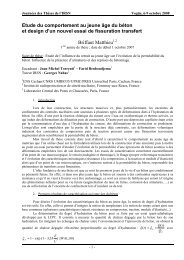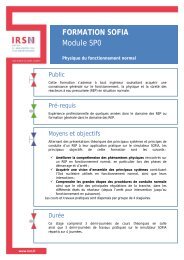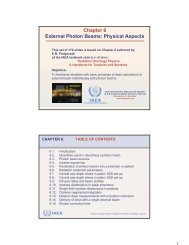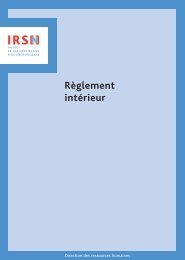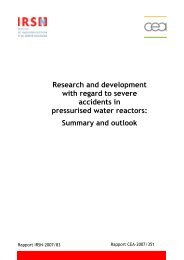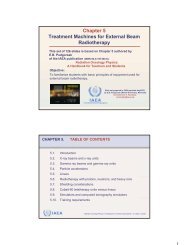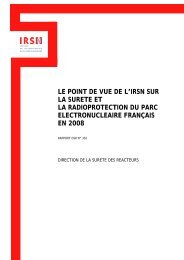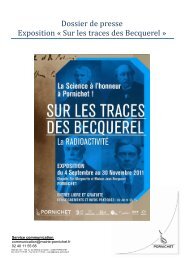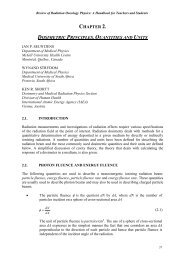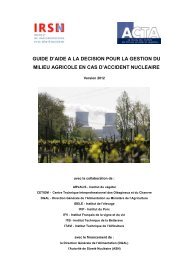Review of Radiation Therapy Physics: A syllabus for teachers ... - IRSN
Review of Radiation Therapy Physics: A syllabus for teachers ... - IRSN
Review of Radiation Therapy Physics: A syllabus for teachers ... - IRSN
Create successful ePaper yourself
Turn your PDF publications into a flip-book with our unique Google optimized e-Paper software.
<strong>Review</strong> <strong>of</strong> <strong>Radiation</strong> Oncology <strong>Physics</strong>: A Handbook <strong>for</strong> Teachers and Students• SAD set-up options employ either an isocentric-type weighting whereby the beamweight is summed at isocenter or a TPR weighting whereby a 100% beam weightproduces a distribution having a value at isocenter in the patient equal to the sum<strong>of</strong> the beams’ TPRs.• Manual or hand checks <strong>of</strong> all dose distributions, as well as beam time or MUcalculations used <strong>for</strong> treatment are recommended. Since many treatment plansinvolve complex beam delivery, these hand checks do not need to be precise, yetthey serve as a method <strong>of</strong> detecting gross errors on the part <strong>of</strong> the TP system.11.5.5. Dose volume histograms and optimization• DVHs must be verified <strong>for</strong> both geometric and calculative accuracy. By drawinggeometric targets, such as spheres or cubes in a phantom, volume calculations canbe verified. A dose distribution displaying a single beam passing through thesphere or cube can be used to verify the DVH calculation <strong>for</strong> both the differentialand cumulative representations.• Optimization routines are provided by many TP systems, and intensity modulatedbeams having complex dose distributions may be produced. As these set-upsinvolve partial or fully dynamic treatment delivery, spot checks <strong>of</strong> absolute doseto a point, as well as a verification <strong>of</strong> the spatial and temporal aspects <strong>of</strong> the dosedistributions using either film or detector arrays are a useful method <strong>of</strong> evaluatingthe TP system beam calculations.11.5.6. Training and documentationTraining considerations and a reasonable amount <strong>of</strong> documentation <strong>for</strong> both the hardware ands<strong>of</strong>tware are essential. Typically the training is given on-site, and at the manufacturer’sfacility. On-going refresher courses are available to familiarize the dosimetrists and physicistswith “bug-fixes” and system upgrades. Documentation regarding s<strong>of</strong>tware improvements andfixes is kept <strong>for</strong> reference by users at the clinic. TP system manufacturers have lists <strong>of</strong> otherusers and resource personnel to refer to.Most manufacturers <strong>of</strong> TP systems organize users’ meetings either as stand alone meetings orin conjunction with national or international scientific meetings <strong>of</strong> radiation oncologists orradiation oncology physicists. During these meetings special seminars are given by invitedspeakers and users describing the particular s<strong>of</strong>tware systems, new developments in hardwareand s<strong>of</strong>tware as well as problems and solutions to specific s<strong>of</strong>tware problems.11.5.7. Scheduled Quality Assurance• Following acceptance and commissioning <strong>of</strong> a computerised treatment planningsystem a scheduled quality assurance (QA) program should be established toverify the output <strong>of</strong> the TP system (see also 12.3.7).• The frequency <strong>of</strong> these tests and the acceptance criteria should be establishedbased on the user’s specific needs or national or international norms. Due to thecomplexity and changing nature <strong>of</strong> TP systems, quality assurance tests found inthe literature (and suggested in these references) may not be sufficient; however,they can give the basis <strong>for</strong> a scheduled program.331



